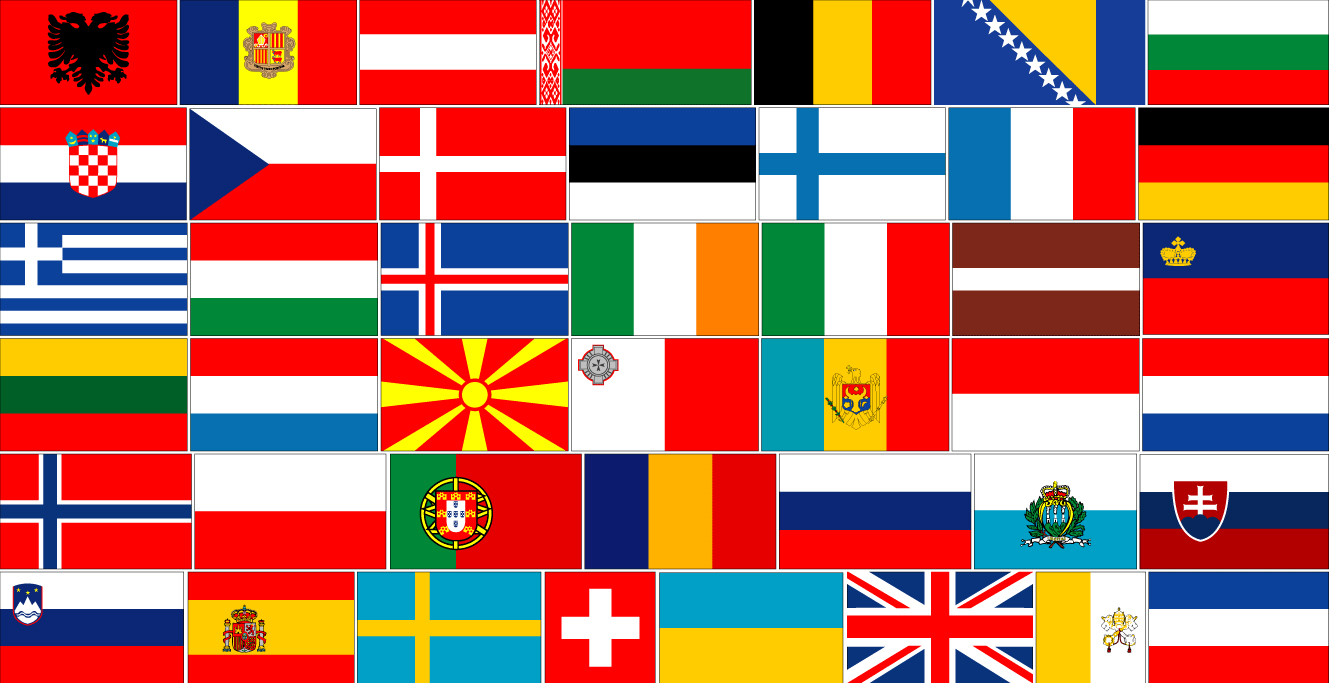KNOWLEDGE AND THE KNOWER—TOOLS
UNRELIABILITY OF EYEWITNESS REPORTING
European flags. Image: GEOATLAS.com
CLASS ACTIVITY I: MEMORIZE SOME FLAGS
Students should work alone for the first part of this activity. Provide each student with two copies of the flag scoresheet that corresponds to the 43 flags of Europe image from GeoAtlas. Printable pdf.
Ask the students, "How many of these flags do you already know?" Tell them to use their first copy of the scoresheet to record the names of the flags they know with a high degree of confidence. They should record their educated guesses too.
Next students should work in pairs to check their answers at The Nations Online Project. Next they should work collaboratively for a full six minutes, using any study technique or short term memory trick that works, to memorize the names as many of the flags as possible.
When the time elapses in silence, and with nothing but the second copy of the flag score sheet to hand, ask students to identify as many flags as possible. They should tally and compare their results briefly with their original partner.
Postpone further discussion for now and move straight in to the next activity. This is a solo online game that will require students to have an electronic devices at hand.
CLASS ACTIVITY II: ONLINE WORLD FLAGS MATCHING TEST
Here is a link to a brain befuddling Flags Memory Game at Memozor. Students should play three times, noting their time and number of moves.
Again save discussion for later, and move without hesitation into the Stroop Test activity. This best tackled with a partner ready to pounce on any error!
CLASS ACTIVITY III: STROOP TEST
Test A:
Work quickly. Do not just read the words. Concentrate on the color of the ink of each word. Say them out loud in order
Test B:
Again, work quickly. Same instructions again, but more tricky this time. Concentrate on the color of the ink of each word. Say them out loud in order.
FOR WHOLE CLASS DISCUSSION
1. Compared with your partner's performance, how successful were you at naming the flags initially? How well did you do after the six minutes of study time? How do you and your partner account for any personal differences?
2. In the online matching game was there anything about the choice of flags that made the task particularly tricky? Did you improve your performance over the three trials? Was that a result of changing your strategy?
3. What was going on when you were participating in the Stroop Test?
CLASS ACTIVITY IV: COUNT THE PASSES
Have some carefully cut squares of paper ready in advance as well as a gourmet chocolate, or some other edible treat, for a prize that you will keep highly visible.
The teacher should frame this deliberately ritualized video activity with dead-pan theatricality. Like the Nacirema activity, the reveal will be all the more effective after some distracting "smoke and mirrors."
Contextualize the video activity by making some direct connections to the Stroop Test. Begin by informing the class that the Stroop Test is an old and highly trusted tool in Psychology. It has been a reliable measure of focus, interference and reaction times, since it was introduced in 1937. It is still widely used in clinical practice. Indeed, some students may have completed a version of it during a learning difference evaluation. Also, in an IB context, it might be worth mentioning that high functioning bilinguals, presumed to have with enhanced executive function in the frontal lobes of their brains, have been shown to do better on the Stroop Test.
Next, pass out the paper squares. Ask students to write their name legibly on one side. Tell them that they are about to work in absolute silence. They will attempt a simple counting test using a video made by some college students. They will only have one chance to win the prize. They must write their answer on the reverse side of the paper as soon as the video stops. Silence is very important. Announce that if any student has seen the video before they should keep that fact to themselves; they will simply have a slight advantage in the competition!
Be ready to stop the video at exactly the 0.37 point. Collect the answer papers before resuming the video.
The selective attention test video was produced by Daniel Simons and Christopher Chabris at Harvard. After some cathartic release and very brief discussion, move straight into the final video. This extract is a cautionary tale about the fallibility of eye witness testimony. Invite students to make connections with all four activities in this unit of inquiry.
If students are still concerned about the prize after the tension and release contained in the second half of the video. Give all the students with a winning ticket a second paper square. Allow a timed one minute to write a description of the Vatican flag! Award the edible treat accordingly.
Chris Ofili (2003) Union Black. Polyester flag in Pan-African colors. Tate Modern, London Photo: Victoria Miro and the artist.


